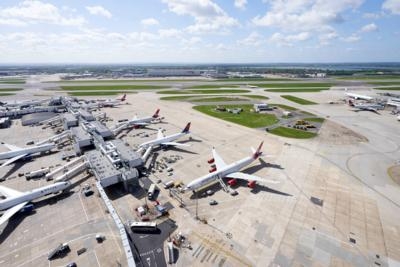Research Will Focus On Heathrow Airport In London
Heathrow Airport is looking to understand how electric aircraft will impact future infrastructure needs with the help of researchers from Cranfield University, the University of Essex and the University of Reading.

The first phase of the Airport Infrastructural Requirements for Electrical Propulsion Systems (AIREPS) project, which started on 1 December, will comprise a six-month feasibility study of the physical infrastructural and airspace components associated with aircraft electrification at Heathrow. An evaluation of potential modelling and simulation tools to help develop a digital twin of these assets will also be conducted.
Outputs from AIREPS will help aid strategic decision making for airports generally as to how they should plan for an increasingly electrically powered future for aviation.
"Heathrow has an important role to play in encouraging the use of cleaner, greener and more innovative aircraft as it focuses on sustainable and responsible growth," said Matt Prescott, Director of the Center of Excellence for Sustainability, Heathrow Airport, which is funding the research. "We have already committed to free landing charges for the first electric aircraft as we believe it to be a viable option in years to come, as the industry decouples growth in aviation with a growth in carbon. Now we are proud to be bringing some of the UK’s brightest universities together to ensure the airport will be ready to support sustainable flight in the future.”

"Safely and efficiently integrating electric aircraft into existing systems and supply chains represents a key challenge to fulfilling the potential offered by this technology," said Dr. Thomas Budd, Lecturer in the Center for Air Transport Management, Cranfield University. "This includes questions around the optimal nature of in-house charging facilities, electrical power and distribution requirements, and certification of safe connections between aircraft and charging infrastructure.”
The research will also consider the impact of electric aircraft in the context of resilience and climate change adaptation. "We know that departing aircraft suffer from reduced lift when the air is warmer, potentially leading to take-off weight restrictions in the summer," said Professor Paul Williams, Department of Meteorology at the University of Reading. "We will use climate model projections to analyse the operational consequences this will have for electric aircraft.”
The research will be informed by the use of advanced virtual infrastructure (digital twin technology), airspace simulation modelling approaches, machine learning, and intelligent analytics, which will be used to explore the complex resource management challenges future flight technologies will create.
"Sustainable aviation is integral to how we as a society continue to use air travel in the future," said Dr. Faiyaz Doctor, from the Intelligent Connected Societies Group at the University of Essex, who is leading on the modelling and simulation part of the research. "To meet this need, the AIREPS project seeks to scope the development of future flight ready infrastructure.”
The project was officially launched at Cranfield’s recent Aviation and the Environment Conference.
Outputs from Phase 1 will be used to inform subsequent phases of the research, where it is envisaged that the live research airport environment at Cranfield, including the Digital Aviation Research and Technology Centre (DARTeC), with other specialist facilities at the University of Reading and University of Essex, could be used be used to enable progress of the research from TRL 3 to 4 (Phase 1) to TRL 5 (pilot scale).
(Image provided with Cranfield University news release)
 ANN's Daily Aero-Term (04.26.24): DETRESFA (Distress Phrase)
ANN's Daily Aero-Term (04.26.24): DETRESFA (Distress Phrase) ANN's Daily Aero-Linx (04.26.24)
ANN's Daily Aero-Linx (04.26.24) Airborne 04.22.24: Rotor X Worsens, Airport Fees 4 FNB?, USMC Drone Pilot
Airborne 04.22.24: Rotor X Worsens, Airport Fees 4 FNB?, USMC Drone Pilot Airborne 04.24.24: INTEGRAL E, Elixir USA, M700 RVSM
Airborne 04.24.24: INTEGRAL E, Elixir USA, M700 RVSM Airborne-NextGen 04.23.24: UAVOS UVH 170, magni650 Engine, World eVTOL Directory
Airborne-NextGen 04.23.24: UAVOS UVH 170, magni650 Engine, World eVTOL Directory




